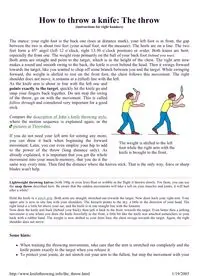
The Throw 2003 PDF
Preview The Throw 2003
How to throw a knife: The throw (instructions for right handers) The stance: your right foot is the back one (toes at distance mark), your left foot is in front, the gap between the two is about two feet (your actual foot, not the measure). The heels are on a line. The two feet form a 45° angel (left 12 o`clock, right 13:30 o`clock position) or wider. Both knees are bent, especially the front one. The weight rests primarily on the ball of your back foot (behind your toes). Both arms are straight and point to the target, which is in the height of the chest. The right arm now makes a round and smooth swing to the back, the knife is even behind the head. Then it swings forward towards the target, like you wanted to chop off some branch between you and the target. While swinging forward, the weight is shifted to rest on the front foot, the chest follows this movement. The right shoulder does not move, it remains in a (tilted) line with the left. As the knife arm is about in line with the left one and points exactly to the target, quickly let the knife go and snap your fingers back together. Do not stop the swing of the throw, go on with the movement. This is called follow through and considered very important for a good stick. Compare the description of John`s knife throwing style, where the motion sequence is explained again, or the pictures at Throwdini. If you do not need your left arm for aiming any more, you can draw it back when beginning the forward movement. Later, you can even employ your hip to add to the power of the throw (long distance only). As already explained, it is important that you get the whole movement into your muscle-memory, that you do it the same way every time. Then find the distance where the knives stick. That is the only way, force or sharp blades won't help. Lightweight throwing knives (with 100g or even less) float or wobble in the flight if thrown slowly. For them, you can use the snap throw described here. Be aware that the sudden movements will take a toll on your muscles and joints, it will hurt after a while! Hold the knife in a pinch grip. Both arms are straight, stretched out towards the target. Now draw back your right arm. Your upper arm is now in one line with your shoulders. The forearm points to the sky, a little in the direction of your head. The right hand is a little bit above your ear, and the knife is in one straight line with the forearm. Now draw the knife arm back (behind your back), then jerk it back to the front, towards the target. Even better then a jerking movement is one where you draw the knife forcefully to the front, a little bit like the knife was attached somewhere in your back with a rubber band. The weight is now shifted to your front foot, the chest swings towards the target. Again, the right shoulder does not move. Some hints: � When training the throwing movements, take care that the arm is stretched out completely and the knife points exactly to the target when you release it. � To protect your joints, do not stretch out your arm to the fullest, but stop the movement with your The weight is shifted to the left foot while the right arm with the knife is brought to the front. 1/19/2003 http://www.knifethrowing.info/the_throw.html muscles. � Again: The wrist remains stiff! Page 2 of 2 how to throw a knife 1/19/2003 http://www.knifethrowing.info/the_throw.html
